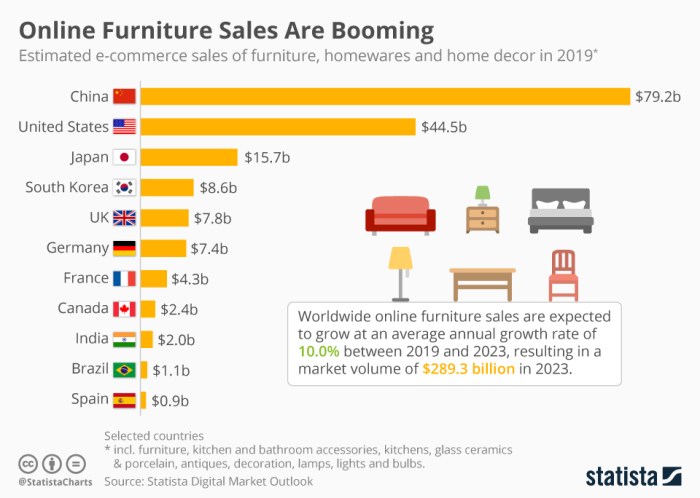E Commerce Fuels Growth in Furniture Sales is reshaping the industry, driving a surge in online purchases. This shift reflects evolving consumer preferences, facilitated by advancements in online platforms and delivery systems. The ease of browsing, comparing prices, and ordering directly from manufacturers or marketplaces is transforming how consumers acquire furniture.
From the historical trends of traditional retail to the innovative technologies employed in online platforms, this exploration highlights the factors propelling this growth. The analysis includes the various e-commerce models, contrasting traditional and online retail, and dissecting the customer journey, from initial browsing to final purchase. We also discuss the logistical challenges and emerging trends shaping the future of online furniture sales.
E-commerce’s Impact on Furniture Sales

Source: statcdn.com
The furniture industry, traditionally anchored in physical showrooms and brick-and-mortar stores, is experiencing a significant transformation driven by the rise of e-commerce. This shift reflects broader consumer trends towards online shopping, offering a wider selection, enhanced convenience, and potentially more competitive pricing. The increasing accessibility and ease of online furniture purchases are fundamentally altering the landscape of the industry.E-commerce has fundamentally reshaped the way consumers shop for furniture, offering unprecedented opportunities for both retailers and customers.
The accessibility of a vast online catalog, coupled with the convenience of home delivery, has become a powerful catalyst for growth. This change in consumer behavior is directly influencing the business strategies of furniture companies, forcing them to adapt to the evolving needs of modern shoppers.
Historical Overview of Furniture Sales Trends
Historically, furniture sales relied heavily on traditional retail models. Showrooms offered a tangible experience, allowing customers to physically examine products and engage with sales representatives. However, the limitations of physical space and limited inventory options restricted both the range and the accessibility of furniture choices. The rise of online marketplaces and e-commerce platforms has enabled furniture retailers to overcome these limitations, offering a much broader selection to a wider customer base.
Key Factors Driving Online Furniture Shopping Growth
Several factors contribute to the burgeoning growth of online furniture shopping. Improved online payment systems and enhanced logistics for home delivery have created a more streamlined and convenient purchasing process. Consumers are increasingly valuing the convenience of browsing and comparing products from diverse sources, without the constraints of geographical limitations. Furthermore, online retailers can often offer competitive pricing due to lower overhead costs compared to traditional stores.
E-commerce Platforms and Furniture Purchases
E-commerce platforms facilitate furniture purchases through their intuitive interfaces and user-friendly design. Online furniture retailers often employ sophisticated search functionalities, allowing customers to easily filter products based on specific criteria such as style, size, material, and price. Detailed product images and 360-degree views provide a virtual equivalent to the in-store experience, aiding in informed purchasing decisions. Seamless online ordering processes and secure payment gateways contribute to a frictionless customer journey.
Models of Online Furniture Retailers
Different models of online furniture retailers cater to varying customer preferences and business strategies. Direct-to-consumer (DTC) models, where the retailer manufactures and sells directly to consumers, often emphasize a unique brand identity and potentially lower prices. Alternatively, online marketplaces provide a platform for various retailers to sell their products, allowing consumers to compare offerings from multiple sources. These diverse models reflect the adaptability and innovation in the e-commerce furniture industry.
Comparison of Traditional vs. Online Furniture Retail
| Feature | Traditional Retail | Online Retail |
|---|---|---|
| Accessibility | Limited by physical store location | Globally accessible 24/7 |
| Price | Potentially higher due to overhead costs | Potentially lower due to reduced overhead |
| Customer Service | Direct interaction with sales representatives | Often relies on online support channels |
The Digital Furniture Experience
The digital realm has fundamentally reshaped the furniture shopping experience. Consumers now interact with furniture virtually, experiencing it in their homes through digital tools and platforms. This digital transformation significantly impacts purchasing decisions, offering a unique and immersive preview of potential purchases.The online furniture marketplace has become increasingly sophisticated, leveraging technology to create a richer, more personalized shopping experience.
Virtual staging tools and high-quality imagery allow potential buyers to visualize furniture pieces in their own spaces, fostering a higher level of confidence and satisfaction with their purchase.
Influence of Online Imagery and Virtual Staging Tools
Online imagery plays a crucial role in convincing consumers to make a purchase. High-resolution photographs and well-lit product shots showcase the furniture’s details and aesthetic appeal effectively. Furthermore, virtual staging tools allow consumers to envision the furniture within their own homes or apartments. This empowers them to visualize the scale, style, and placement of pieces with precision. The more realistic the digital presentation, the more likely consumers are to feel confident about the purchase.
The seamless integration of virtual staging tools with product photography is key to improving online furniture sales.
Innovative Technologies and Design Tools
E-commerce furniture platforms are constantly evolving, introducing innovative technologies to enhance the shopping experience. Advanced 3D modeling software allows for detailed representations of furniture, offering multiple viewing angles and allowing consumers to interact with the product virtually. Interactive design tools empower users to customize furniture arrangements and visualize different aesthetics in their space.
- 3D Modeling: 3D models offer detailed, interactive views of furniture, providing a highly engaging experience for customers. This enables them to rotate, zoom, and examine the product from all angles, enhancing their understanding of its dimensions and features.
- Virtual Reality (VR): VR technology immerses consumers in a simulated environment, allowing them to experience the furniture within their own space. Imagine virtually placing a sofa in your living room, experiencing its size and style in a realistic setting.
- Augmented Reality (AR): AR technology overlays digital furniture models onto real-world spaces, enabling users to preview the furniture in their existing environments. Customers can virtually place a dining table in their dining area and see how it fits, creating a seamless transition between the digital and physical worlds.
- Interactive Design Tools: Sophisticated design tools allow customers to customize furniture arrangements, selecting colors, fabrics, and styles. This empowers them to tailor the look and feel of the furniture to their personal taste.
Role of 3D Models, VR, and AR
D models provide a detailed visual representation of furniture, facilitating a thorough understanding of its dimensions and characteristics. VR allows customers to experience the furniture in a simulated environment, effectively bringing the product to life. AR overlays digital furniture models onto real-world spaces, enabling customers to envision the furniture in their homes before making a purchase. These technologies play a crucial role in the digital furniture experience.
Importance of High-Quality Product Photography and Detailed Descriptions
High-quality product photography is essential for showcasing the beauty and details of furniture. Clear, well-lit images, showcasing various angles and features, are paramount to building trust and confidence in online purchases. Detailed descriptions, including material specifications, dimensions, and assembly instructions, provide crucial information to support informed decision-making.
Visual Presentation Strategies
| Presentation Style | Example | Effectiveness |
|---|---|---|
| High-Resolution Product Photography | Clear, well-lit images showcasing furniture from multiple angles. | Creates a realistic impression of the product, enhancing trust and reducing uncertainty. |
| Virtual Staging | Showing furniture pieces within a digitally rendered room. | Allows consumers to visualize the furniture in their own space, increasing purchase confidence. |
| Interactive 3D Models | Allowing users to rotate, zoom, and explore furniture in detail. | Provides a comprehensive understanding of the product’s design and dimensions, reducing purchase anxieties. |
| Lifestyle Photography | Images of people using the furniture in everyday scenarios. | Creates a connection between the product and the consumer’s lifestyle, enhancing the product’s appeal. |
| Detailed Descriptions | Precise measurements, material information, assembly instructions. | Provides essential information to make informed decisions and addresses potential concerns before purchase. |
Customer Behavior and Preferences

Source: matterhorn-wholesale.com
Online furniture purchases are rapidly gaining traction, and understanding the motivations and preferences of these customers is crucial for success in this evolving market. This segment delves into the key demographics, buying motivations, and influencing factors shaping the online furniture shopping experience.The rise of e-commerce has fundamentally altered how consumers acquire furniture. Traditional in-store experiences are being supplemented, and sometimes even superseded, by the convenience and accessibility of online platforms.
This shift necessitates a deep understanding of the evolving preferences and behaviors of online furniture buyers.
Key Customer Demographics Driving Online Furniture Purchases
Online furniture shoppers often exhibit specific demographic characteristics. Millennials and Gen Z, known for their tech-savviness and preference for convenience, represent a significant portion of this group. Additionally, urban dwellers frequently gravitate toward online purchases due to limited storage space and the time-saving aspect of home delivery. Location also plays a role, as online retailers often offer wider product selections and competitive pricing compared to local stores, potentially appealing to consumers in areas with limited brick-and-mortar options.
Motivations and Needs of Online vs. In-Store Furniture Buyers
Online furniture buyers often prioritize convenience and price comparison, leveraging the vast selection available online. They appreciate the ability to research and evaluate products from different brands and retailers without leaving their homes. In-store buyers, on the other hand, often value the tactile experience of physically examining the furniture, the opportunity for immediate purchase, and personalized advice from sales representatives.
Factors Influencing Online Furniture Purchases
Several factors significantly impact online furniture purchases. Price comparison tools and competitive pricing are essential to online consumers, who often research multiple retailers before making a decision. Delivery options, including speed, cost, and potential installation assistance, are crucial factors. Likewise, comprehensive and trustworthy return policies are vital for building customer confidence and reducing potential buyer’s remorse.
Significance of Reviews and Ratings in Shaping Consumer Trust
Online reviews and ratings play a critical role in building consumer trust and influencing purchase decisions for online furniture. Positive reviews and high ratings build credibility and encourage potential buyers. Conversely, negative reviews can deter customers and influence their choices. Understanding how consumers perceive and utilize reviews is essential for retailers to manage their online reputation and build customer loyalty.
Method for Organizing Data on Customer Preferences
A structured data method is essential for effectively tracking and analyzing customer preferences. A database, with the example structure provided below, can store customer demographics, purchase history, feedback, and other relevant information. This structured approach enables retailers to gain valuable insights into customer preferences and tailor their offerings to meet specific needs and desires.
Example Data Structure:“`json “customerID”: 123, “age”: 35, “location”: “New York”, “purchaseHistory”: [ “product”: “sofa”, “price”: 1500, “product”: “dining table”, “price”: 800 ], “feedback”: “Very satisfied with the delivery.”, “preferredStyle”: “Modern”, “returnReason”: null“`
Logistics and Fulfillment: E Commerce Fuels Growth In Furniture Sales
Online furniture sales have exploded in popularity, but the journey from digital storefront to customer doorstep presents unique challenges. Effective logistics and fulfillment strategies are crucial for success in this sector, ensuring customer satisfaction and maintaining a competitive edge. Robust systems and efficient processes are paramount for maintaining positive brand perception and driving repeat business.Delivering furniture online differs significantly from other retail sectors.
The sheer size, weight, and fragility of furniture pieces demand specialized handling, packaging, and transportation solutions. A careful approach to these elements ensures timely and damage-free delivery, ultimately shaping the customer experience. Efficient logistics providers and optimized delivery processes are instrumental in this critical step of the online furniture purchase journey.
Challenges of Online Furniture Delivery
The unique characteristics of furniture present significant logistical hurdles. Fragility and large dimensions necessitate robust packaging and specialized handling procedures. Precise measurements and accurate loading and unloading techniques are crucial to prevent damage during transit. Delivery to multiple floors within a building or to remote locations can also pose complexities. Furthermore, the variability in furniture sizes and types requires flexible and adaptable logistics solutions.
Strategies to Overcome Delivery Challenges
Innovative approaches to furniture packaging and delivery are key to overcoming these challenges. Using custom-designed crates and reinforced materials minimizes damage during transit. Employing specialized loading and unloading techniques ensures safe handling at every stage. Developing partnerships with logistics providers experienced in handling bulky goods is also essential. Offering flexible delivery options, such as scheduled deliveries or multiple delivery windows, enhances customer convenience and satisfaction.
Providing real-time tracking updates keeps customers informed and engaged throughout the delivery process.
Role of Logistics Providers
Logistics providers play a pivotal role in facilitating seamless online furniture purchases. They offer specialized expertise in handling large and fragile items, ensuring safe and timely delivery. Their networks of transportation and warehousing facilities are crucial for efficient distribution. Their experience with handling varied furniture types and sizes enables them to tailor solutions to individual needs. Partnerships with reputable logistics companies provide access to advanced technologies and processes, enhancing the delivery experience for customers.
Efficient Delivery Processes
Efficient delivery processes are essential for a positive customer experience. Meeting promised delivery timelines and offering a variety of delivery options are crucial. Providing clear and comprehensive communication regarding delivery updates, including real-time tracking, is essential. Utilizing advanced technology for route optimization and real-time monitoring can improve delivery speed and reliability. This can also allow for proactive communication regarding potential delays or changes to the delivery schedule.
Innovative Approaches to Packaging and Delivery
Several innovative approaches to packaging and delivery are being employed by forward-thinking online furniture retailers. Using custom-designed crates and protective padding minimizes damage during transit. Employing modular packaging allows for efficient packing and unpacking. Implementing secure and tamper-proof packaging solutions safeguards against potential issues during transit. Integrating technology to track the condition of the furniture during transport, allowing for proactive identification of potential damage issues, can minimize potential losses and ensure a positive experience.
Delivery Options Comparison
| Delivery Method | Cost | Time |
|---|---|---|
| Standard Delivery | Low | 3-7 days |
| Express Delivery | High | 1-3 days |
| White Glove Delivery | High | 2-5 days |
| Freight Delivery | Low | 5-10 days |
| Scheduled Delivery | Moderate | Flexible |
Future Trends in Online Furniture Sales
The online furniture market is rapidly evolving, driven by technological advancements and changing consumer preferences. This dynamic environment presents both challenges and opportunities for retailers. Understanding these emerging trends is crucial for staying competitive and maximizing profitability in the years to come.The future of online furniture sales hinges on embracing innovative technologies and adapting to evolving customer expectations.
This includes offering seamless online experiences, personalized recommendations, and streamlined logistics. Moreover, integrating sustainability and eco-friendly materials into the product offering will become increasingly important as consumer awareness grows.
Personalized Recommendations and AI-Driven Design Tools
Artificial intelligence (AI) is poised to revolutionize the online furniture shopping experience. AI-powered recommendation systems can analyze customer data to suggest products tailored to individual preferences, enhancing customer satisfaction and conversion rates. Furthermore, AI-driven design tools can allow customers to visualize furniture in their homes before purchase, providing a more immersive and interactive shopping experience. Examples include virtual reality (VR) and augmented reality (AR) applications, allowing users to virtually place furniture in their homes to see how it looks and fits.
Sustainability and Eco-Friendly Materials, E Commerce Fuels Growth in Furniture Sales
Consumer demand for sustainable and eco-friendly products is on the rise. Online furniture retailers must embrace this trend by incorporating sustainable materials into their offerings, such as recycled wood, bamboo, or reclaimed materials. This focus on sustainability will not only attract environmentally conscious customers but also enhance the brand image. For instance, IKEA’s commitment to sustainable materials and production processes has resonated with environmentally aware consumers.
Future Challenges and Opportunities for Online Furniture Retailers
Competition in the online furniture market is intensifying. Retailers must focus on differentiating themselves through unique offerings, superior customer service, and seamless omnichannel experiences. The rising costs of logistics and fulfillment will require strategic partnerships and innovative solutions. Opportunities lie in developing bespoke furniture designs, incorporating customer feedback in the design process, and enhancing the user experience with new technologies.
This will allow for greater flexibility and efficiency, ultimately enhancing customer satisfaction and brand loyalty.
Future Innovations in Furniture Delivery and Assembly
The delivery and assembly of furniture are critical components of the online shopping experience. Future innovations in this area will likely include drone delivery for smaller items, advanced packaging techniques to prevent damage, and automated assembly solutions for certain furniture types. Smart furniture that can be controlled remotely and offers self-assembly features could be a game-changer. For example, furniture that adjusts its height automatically or has components that connect with simple clicks could significantly reduce assembly time.
Concluding Remarks

Source: thesiliconreview.com
In conclusion, the rise of e-commerce is fundamentally altering the furniture industry. The seamless online experience, combined with innovative technologies and customer-centric strategies, is driving this growth. While challenges in logistics and delivery exist, the future of furniture retail is undoubtedly intertwined with the digital landscape. Consumers are increasingly drawn to the convenience and vast selection offered by online platforms, while retailers are adapting to meet these evolving demands.
Essential Questionnaire
What are the key factors driving online furniture shopping?
Factors include increased convenience, wider product selection, and often competitive pricing compared to traditional stores. The ability to research and compare products easily is also a significant driver.
How do online retailers enhance the shopping experience?
Advanced visual tools like 3D models, virtual staging, and augmented reality allow customers to visualize furniture in their homes. High-quality images and detailed descriptions also play a crucial role in this process.
What are the challenges in delivering furniture online?
Delivering furniture involves challenges related to size, weight, and fragility. Efficient logistics, reliable delivery partners, and effective packaging strategies are crucial to overcoming these hurdles.
How important are reviews and ratings for online furniture purchases?
Customer reviews and ratings are vital for building trust and confidence in online purchases. Positive reviews can influence purchasing decisions, while negative feedback helps retailers address potential issues.